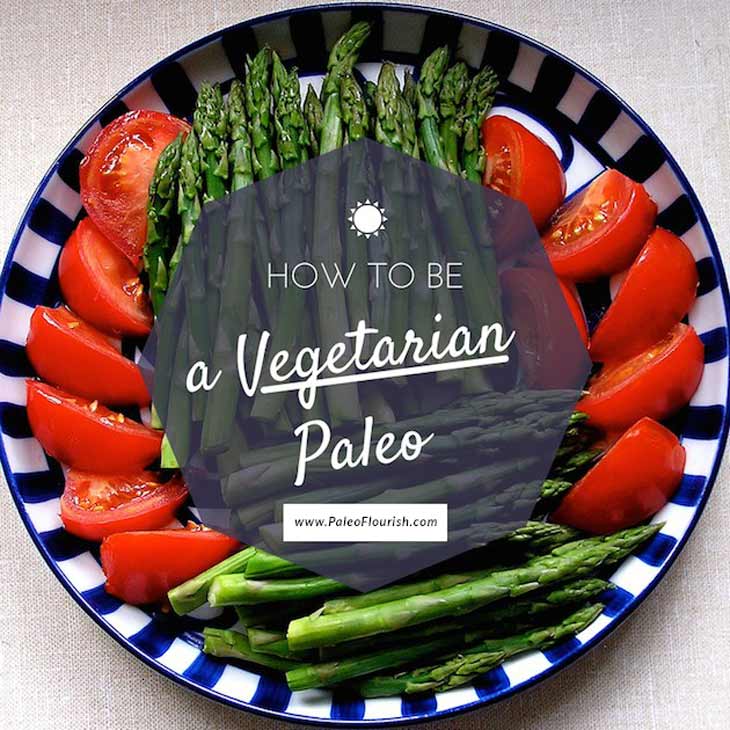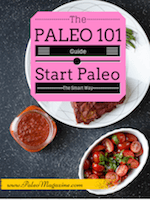How to be a Vegetarian Paleo

A vegetarian Paleo might sound like an oxymoron to you, but it’s actually something that is quite possible.
Having said that, being a vegetarian Paleo (or Paleo vegetarian) is not easy and will require you to tailor your Paleo diet to ensure you get all the nutrients you need. That’s what this article is all about. Below you’ll find suggestions on how best to do a vegetarian Paleo diet.
If you prefer watching videos, then we’ve got a video on this topic below – otherwise skip down to read the article.
Why go on a Vegetarian Paleo Diet?
There are a variety of reasons why you might want to be a vegetarian (from animal welfare to religious reasons), but this article is not going to debate any of those possible reasons.
So, why would you want to be Paleo even if you’re a vegetarian?
I personally believe that eating a diet high in nutritious foods while cutting out those foods that can cause harm to our bodies over time is the best thing to do, and Paleo offers this approach.
So, even if you don’t eat meat, you can still eat fruits, vegetables, nuts and seeds, and healthy fats, and those are all components of Paleo that are great. And perhaps even more importantly, you will still benefit from cutting out foods like wheat, other grains, and processed sugars.
So here are 6 things you should consider on a vegetarian Paleo diet.
6 Considerations When Eating a Vegetarian Paleo Diet
1. Eat eggs.
One of the toughest aspects about being a vegetarian Paleo is getting sufficient protein (nuts only offer so much protein and it’s best not to overeat nuts due to their high phytic acid content and how easy they are to overeat).
For example, one cup of scrambled eggs provides over 24 of protein. A cup of almonds provides 20g of protein.
How much protein do you actually need?
This is definitely a debated question. The DRI (Dietary Reference Intake) is 0.8 grams of protein per kilogram of body weight, or 0.36 grams per pound, but there are suggestions that this is on the low side. Kris Gunners suggests 56-91 grams per day for the average male and 46-75 grams per day for the average female. And eggs can go a long way to helping you get sufficient protein.
Another benefit of eggs is the vitamin B12 it provides (another nutrient that can be tough to get as a vegetarian). One cup of scrambled eggs provides 28% of your daily value of B12.
Eggs play a large part in regular Paleo diets already – they’re just so easy and fast to cook. An easy and filling breakfast option is a couple of boiled eggs with an avocado.
2. Consider eating Dairy.
Although dairy is generally not considered Paleo due to a variety of reasons according to Dr. Loren Cordain (including lactose intolerance, hormones in the milk, potential for causing allergies and autoimmune issues), it may be worthwhile considering consuming dairy (especially raw and fermented) to add some extra nutrition (like healthy fats to help absorb fat-soluble vitamins and vitamin B12).
Many people who follow a Paleo diet already add dairy into their diets (e.g., Mark Sisson’s Primal diet, which is sometimes called lacto-paleo), and there is evidence that dairy could be really healthy for you (especially raw and fermented dairy). However, if you are lactose intolerant, have gluten or casein sensitivities, or irritable bowel syndrome (IBS), then consuming dairy may not be good for you.
3. Consider eating Beans.
Generally, beans and other legumes (like soy and peanuts) aren’t part of a Paleo diet for a variety of reasons (this article provides 10 such reasons). However, many of those reasons disappear if you soak, sprout, and cook the beans well. This is definitely something to consider if you aren’t eating eggs and dairy as beans provide fairly good nutrients (e.g., 16g of protein in a cup of red beans).
However, you should be aware that some people with existing digestive issues may have trouble digesting beans (it’ll make you bloated and gassy). Here are 10 ways to help digest beans more easily, but if the problem continues, then you might want to avoid beans and start eating more of another Paleo protein sources. Another issue to watch out for with beans is that they are high in carbohydrates, which may be an issue if you have blood sugar or weight issues.
Note – soy and peanuts are still not recommended due to other issues with them. (This article explains why soy is problematic and this article explains why peanuts are not Paleo.)
4. Supplementation – Just in Case
Even if you’re on a Paleo diet, supplementation can still be a good idea (as explained in this article). Vitamin B12 is often lacking in vegetarian diets along with certain minerals like iron and calcium. Good omega-3 sources may also be lacking in a vegetarian Paleo diet (so, taking fish oil may be an additional consideration).
5. Be a Pescatarian
If you’re ok with eating fish and shellfish, then it would definitely help to add in lots of extra nutrition (e.g., selenium, B12, B6, niacin, omega-6 fatty acids).
6. Don’t Forget Healthy Fats
One of the main confusions for people starting a Paleo diet is fats. Despite all the fears about fats, the fact of the matter is..you need certain fats to live! Additionally, you’ll end up deficient in many vitamins if you’re not eating sufficient good fats.
There are some fats that aren’t healthy, and those include a lot of seed and vegetable oils (the issue with them is often high omega-6 to omega-3 levels as well as ease of oxidation – you can read more about it in this article). But there are lots of healthy fats you can eat on a vegetarian Paleo diet – coconut oil, olive oil, avocado oil, and macadamia oil. I would recommend cooking most foods in coconut oil and using olive oil for salads.
Looking for Vegetarian Paleo Recipes?
Everyone always loves recipes, so here are some websites to look at for vegetarian Paleo recipes (remember that there are a lot of differing views on what a vegetarian Paleo diet should look like so you’ll have to use your own judgement about what you want to put into your body):
No Meat Athlete
Simply Vegetarian and Pescatarian Paleo
Plus, here’s a list of vegetarian Paleo recipes on paleoflourish.com: https://paleoflourish.com/paleo-recipes#paleo-vegetarian-recipes
Can you be a vegan Paleo?
This isn’t the topic of this article, but I wanted give my two cents on this issue since it’s highly debated still. I personally don’t think veganism is an optimal diet, but doing a vegan diet that follows Paleo ideas is still better than doing a gluten and sugar-filled vegan diet. If you’re interested in following a vegan Paleo diet, then take a look at Kelsey’s Paleo Veganista blog here.
Have you tried a vegetarian Paleo diet?
If so, what are your thoughts on it?
Images: Copyright (c) calliope

